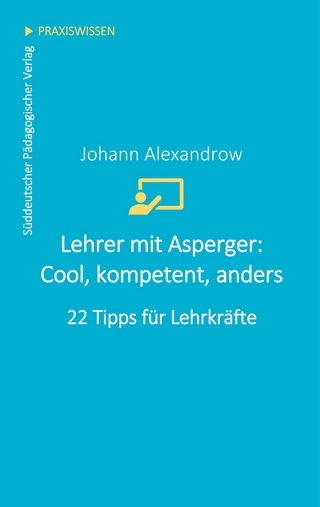
Disability in Higher Education
Jossey-Bass Inc.,U.S. (Verlag)
978-1-118-01822-4 (ISBN)
- Lieferbar
- Versandkostenfrei
- Auch auf Rechnung
- Artikel merken
Create campuses inclusive and supportive of disabled students, staff, and faculty Disability in Higher Education: A Social Justice Approach examines how disability is conceptualized in higher education and ways in which students, faculty, and staff with disabilities are viewed and served on college campuses. Drawing on multiple theoretical frameworks, research, and experience creating inclusive campuses, this text offers a new framework for understanding disability using a social justice lens. Many institutions focus solely on legal access and accommodation, enabling a system of exclusion and oppression. However, using principles of universal design, social justice, and other inclusive practices, campus environments can be transformed into more inclusive and equitable settings for all constituents.
The authors consider the experiences of students, faculty, and staff with disabilities and offer strategies for addressing ableism within a variety of settings, including classrooms, residence halls, admissions and orientation, student organizations, career development, and counseling. They also expand traditional student affairs understandings of disability issues by including chapters on technology, law, theory, and disability services. Using social justice principles, the discussion spans the entire college experience of individuals with disabilities, and avoids any single-issue focus such as physical accessibility or classroom accommodations.
The book will help readers:
Consider issues in addition to access and accommodation
Use principles of universal design to benefit students and employees in academic, cocurricular, and employment settings
Understand how disability interacts with multiple aspects of identity and experience.
Despite their best intentions, college personnel frequently approach disability from the singular perspective of access to the exclusion of other important issues. This book provides strategies for addressing ableism in the assumptions, policies and practices, organizational structures, attitudes, and physical structures of higher education.
Nancy J. Evans, is a professor in the School of Education and former coordinator of the master's program in student affairs at Iowa State University. She is the coauthor of Student Development in College, Second Edition??and??Foundations of Student Affairs Practice, both from Jossey-Bass. Ellen M. Broido, is an associate professor of higher education and student affairs at Bowling Green State University in Ohio. Kirsten R. Brown, is a student affairs professional at the University of Wisconsin-Madison and a part-time faculty member at Madison College. Autumn K. Wilke, is assistant dean of disability resources at Grinnell College, in Iowa.
List of Tables and Figures ix
Acknowledgments xi
Preface xiii
About the Authors xxv
Introduction: A Social Justice Foundation 1
Part One: Foundational Concepts 9
1 A History of Disability in Higher Education 11
Deaf Education 13
Influence of War Veterans 23
Disability Activism 33
Conclusion 45
Discussion Questions 46
Appendix: Significant Moments in the History of Disability in the United States 46
2 Disability Models 54
Established Models 55
Critical Approaches to Disability 66
Social Justice (Ableist or Disability Oppression) Model 71
Emerging Models 76
Conclusion 78
Discussion Questions 80
Appendix: Summary of Disability Models 81
3 Disability, Law, and Education in the United States 91
Historical Overview 92
Legislative Implications 101
Pending and Future Legal Issues 110
Conclusion 120
Discussion Questions 120
4 Dimensions of Impairment and Disability 122
Creating Categories and Labels 123
Categorizing Impairment 125
Impairments Commonly and Increasingly Seen in College Populations 131
Conclusion 139
Discussion Questions 139
Part Two: Population-Specific Experiences 141
5 Disability Identity Development and Multiple Aspects of Identity 143
Multiple and Intersecting Social Identities 144
Disability Identity Development in College Students 145
Self-Identification as Disabled 155
Social Identities 157
Areas for Future Research 168
Implications for Higher Education 169
Conclusion 172
Discussion Questions 173
6 Student Populations 174
Adult Learners 176
Community College Students 177
Transfer Students 180
English Language Learners and English as an Additional Language 181
First-Generation Students 182
International Students 183
Parenting Students 184
Student Athletes 186
Students of Size 187
Undocumented Students 189
Veterans 191
Favorite Hobbies, Yappy Dogs, and Now What? 193
Conclusion 195
Discussion Questions 196
7 Faculty and Staff with Disabilities 197
Perspectives on Disabled Faculty and Staff 199
Barriers That Disabled Faculty and Staff Face in Higher Education 204
Experiences of Disabled Staff and Faculty 209
Creating an Inclusive Climate 214
Conclusion 220
Discussion Questions 221
Part Three: Environmental Issues 223
8 The Campus Environment 225
Physical Environment 226
Organizational Environment 227
The Human Aggregate 230
Social Construction of Disability 237
Creating Campus Environments That Support Students with Impairments 240
Creating a Socially Just Campus Environment 249
Conclusion 251
Discussion Questions 251
9 The Campus Climate 253
Definition of Climate 254
The Campus-Based Experiences of Impaired Students 255
The Impact of Climate on Disabled Students 260
Studying Campus Climate 263
Transforming the Campus Climate 268
Conclusion 272
Discussion Questions 273
10 Universal Design 274
Principles of Universal Design 275
The Evolution From Barrier-Free Design to Universal Design 277
Application of Universal Design in Higher Education 280
Universal Design in Instruction 284
Critiques of Universal Design and Universal Design for Learning 295
Universal Design and Social Justice 298
Resources for Additional Information 300
Conclusion 301
Discussion Questions 302
11 Assistive and Learning Technology 303
History of Assistive Technology 304
Accessible, Adaptive, and Universally Designed Technology 305
Guidelines for Accessible Design 308
Technology as an Accommodation 312
Barriers and Inaccessible Technology 313
Legal Requirements for Technology and Postsecondary Education 316
Eight Steps to Creating an Accessible Campus Technology Culture 319
Conclusion 322
Discussion Questions 323
12 Classroom Instructional Interventions 324
Current Practice 325
Effective Classroom Practices 331
Practices of Specific Academic Disciplines 337
Alternative Instructional Approaches 343
Conclusion 350
Discussion Questions 351
Part Four: Serving Students 353
13 Disability Resource Offices 355
Historical Overview of Disability Resources 356
Disability Resources Today 357
Core Activities of Disability Resource Offices 363
Considerations for the Future of Disability Resources 379
Conclusion 380
Discussion Questions 381
14 Student Affairs 382
Persistence, Retention, and Graduation of Students with Disabilities 383
Importance of Knowledge About Disability in Student Affairs 386
Universal Design in Student Affairs 388
Functional Areas in Student Affairs 390
Conclusion 410
Discussion Questions 410
15 Transitions and Student Affairs 411
Entering Postsecondary Education 412
Transitions During Postsecondary Education 425
Exiting Postsecondary Education 431
Conclusion 437
Discussion Questions 437
Conclusion: A Social Justice Approach to Disability in Higher Education: Strategies for Inclusion 438
Strategies for Creating More Socially Just Campuses 440
Conclusion 447
References 448
Index 501
| Erscheinungsdatum | 02.04.2017 |
|---|---|
| Verlagsort | New York |
| Sprache | englisch |
| Maße | 180 x 239 mm |
| Gewicht | 885 g |
| Themenwelt | Sozialwissenschaften ► Pädagogik ► Bildungstheorie |
| Sozialwissenschaften ► Pädagogik ► Erwachsenenbildung | |
| Sozialwissenschaften ► Pädagogik ► Sonder-, Heil- und Förderpädagogik | |
| Sozialwissenschaften ► Soziologie | |
| ISBN-10 | 1-118-01822-2 / 1118018222 |
| ISBN-13 | 978-1-118-01822-4 / 9781118018224 |
| Zustand | Neuware |
| Haben Sie eine Frage zum Produkt? |
aus dem Bereich


